There’s no doubt about it… spring can be an overwhelming time for gardeners! So, to make things easier, I’ve put together comprehensive spring garden and yard clean up checklists for you.
Plus I’ll tell you when and how to spring clean your garden, give you tons of tips, and share a few of my favorite tools that will help you get the job done faster.
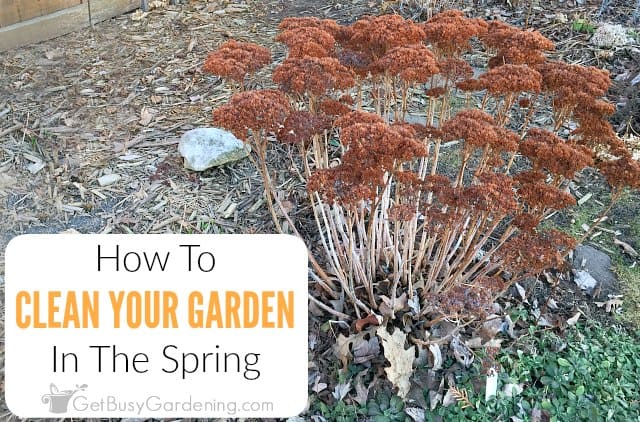
One of the first steps all home gardeners should take in the spring is a good garden clean up.
Beyond just the appearance, there are many benefits too, like reducing potential for disease and weeds during the growing months.
Instead of just attacking winter’s mess, first read my guide explaining not only why, but when to start, and how to do a spring garden cleanup properly and productively.
Below you’ll find all that information and more, including a checklist of essential yard chores that will help you tackle cleaning, and set your garden up for success.
Why Clean Up Your Garden In Spring?
Dead plants, stems, and leaves littering your beds not only look bad, but could be unhealthy. They harbor disease and fungus spores that can end up causing major problems later on in the season.
All of that dead material also hides weeds that can quickly take over if left unattended.
So, it’s always a good idea to do some spring cleaning to help keep your garden disease and weed free, and looking its best.
When To Clean Up The Garden
Wait until the temps are in the 50s°F consistently before beginning your spring garden clean up.
Many types of bees and other pollinators hibernate in plant stems and leaves over winter, and won’t emerge until it’s warm enough. You don’t want to accidentally kill them by starting too early.
It’s also best to wait until the ground has thawed and dried out a bit. If you start walking around in your beds while the soil is still wet, it can cause compaction.
This can make it very difficult for plants to grow later on (plus, you might lose a shoe in the muck…not that I would know anything about that).
Related Post: Spring Houseplant Care Checklist
Tools For Spring Cleaning Your Garden
There are a lot of great tools that will make the job of spring garden clean up much easier and faster. Here are a few of my favorites…
- Garden shears – Since pruning is a huge part of tidying your garden in the spring, you’ll definitely need a nice pair of shears. Always make sure they are clean and sharp before getting started.
- Heavy-duty hand pruners – Regular shears are great for most jobs. But these heavy-duty hand pruners are designed to make cutting through thick stems and branches effortless.
- Loppers for thick branches and stems – I never knew I needed a pair of loppers until I tried them. This amazing tool makes it super easy to cut through thick roots, or tree and shrub branches like they’re butter!
- Hand rake – This handy tool is used for removing leaves and other debris around plants and stems. A hand rake is especially useful when you’re cleaning up around prickly or thorny plants.
- Weeding tool – This is another slick tool you didn’t know you needed until you have one! The Cobrahead weeder and a hook saw are both great for digging into the soil, and quickly and easily uprooting weeds and grass.
- Hedge shears – Another good tool to have as you work to spring clean your garden is a pair of hedge shears. They make quick work of cutting down dead perennials, or shaping unruly shrubs.
How To Spring Clean Your Garden & Yard
Just like any task that involves cleaning indoors, outdoor clean up can be a major chore – especially when you have lots of garden beds like I do. But don’t worry, you don’t have to get it all done in one day.
To make it easy for you, below I’ve broken the list down into smaller tasks that you can do throughout the spring. Take your time and work through the checklists at your own pace.
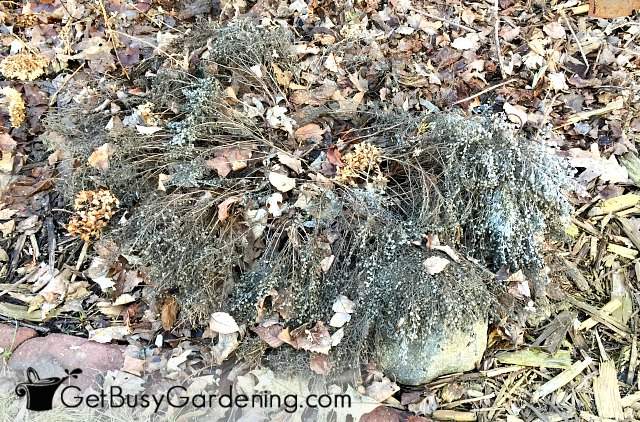
Spring Garden Clean Up Checklist
I’ll go into details on each of these items below, but here’s a quick look at the tasks in my spring gardening cleanup checklist…
- Prune shrubs
- Remove winter mulch
- Brush back leaves on top of plants
- Pull any dead annuals
- Remove dead growth from perennials
- Clean up your vegetable beds
- Pull the weeds
- Edge your garden beds
Prune Shrubs
Early spring is a great time for pruning. It triggers new growth and helps to prevent disease issues. But don’t trim early blooming shrubs just yet.
Wait until after they’re done flowering, or you could wind up cutting off all of the buds by accident. Learn more about when and how to prune plants here.
Remove Winter Mulch & Other Protection
Once the temperature starts to warm up, you can remove any winter mulch you may have added over your sensitive plants last fall.
You should also remove burlap wraps, wind screens, plant cones, or any other types of winter protection you added in the fall.
Brush Back Thick Leaves
A common garden clean up question I get is, “should you remove leaves from flower beds in spring?”.
Don’t worry, you don’t need to remove all of the leaves from your beds; they are actually really good for the soil. Leaves act as a layer of mulch to help keep the weeds down, and also feed the plants as they decompose.
Just be sure to brush back any thick layers of leaves that are sitting on top of your plants. If you want to add mulch, you can just lay it right over top of the leaves.
Pull Dead Annuals
Annual flowers like petunias, begonias, marigolds, geraniums and snap dragons only live for one year in harsh climates, and won’t grow back after winter.
So, you should pull them out of the ground, roots and all, and toss them into the compost bin. Learn how to tell the difference between annuals and perennials here.
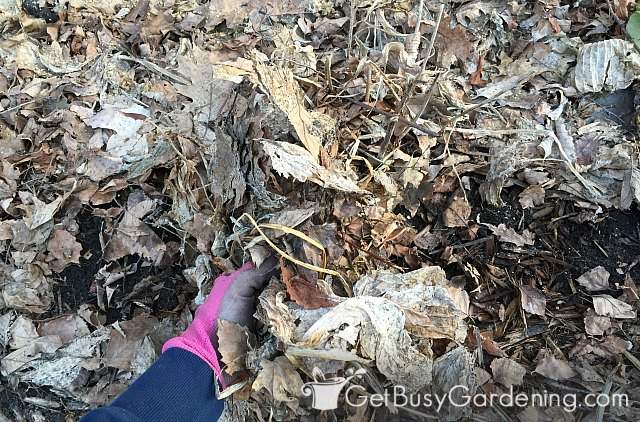
Remove Dead Growth From Perennials
Prune or pull the dead leaves from perennials like hostas, day lilies, ornamental grasses, coneflowers and sedums.
You don’t need to be too diligent about cleaning flower beds in spring. Just be sure to remove any thick clumps of leaves that are on top of the plants so they won’t slow new growth.
Take care when trimming around the base of plants during spring garden clean up so you don’t accidentally cut off new growth.
Also, don’t try too hard to pull dead leaves and stems from the ground. If you force it too much, you could end up pulling out new roots or growth in the process. If there’s resistance when you try to pull, then prune it out instead.
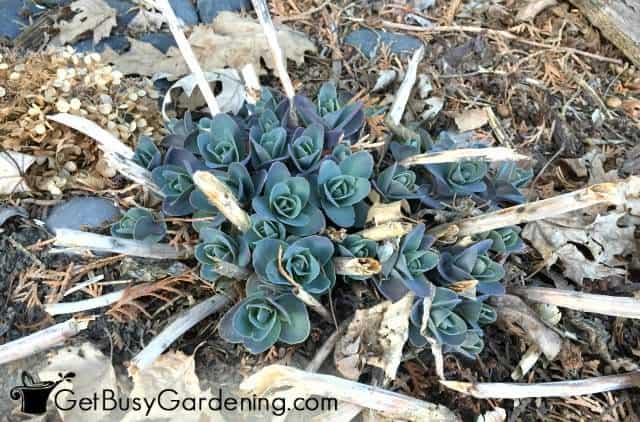
Clean Up Your Vegetable Garden
Pull out any dead vegetables that you didn’t get around to removing last fall. Try to remove as much of the plant debris and roots as possible as you clean up your veggie beds.
Also, detangle any dead vines from trellises and growing supports to make them look nicer as new vines take their time growing in.
Pull Weeds
Spring is a great time to get a jump on cleaning up and pulling weeds before they have time to become established.
Weeds are easy to see before all the perennial plants start filling in. Plus, since the ground is wet from the snow melt, they’re easier to pull too.
Once you’re done weeding, cover the soil with a thick layer of mulch to help keep new weeds from sprouting.
Edge Garden Beds To Remove Grass
Grass has a way of creeping into your beds, and it easily goes unnoticed through the busy summer months.
Spring is the perfect time to edge your beds to clean up and remove the stray grass. Once you have the debris and weeds cleaned up, the grass is easier to see. It’s also simple to pull out, since the soil is wet.
Spring Yard Clean Up Checklist
In addition to cleaning the garden, there are a few spring yard clean up tasks you should do too.
Here’s a quick to do list of other yard tasks, with the detailed tips and instructions below…
- Pick up around the lawn
- Prune your trees
- Wash patio furniture
- Sweep the deck, patio, and porch
Lawn Clean Up
Pick up branches, remove large piles of dead leaves, and clean up any other debris that has accumulated on the grass.
I know it’s tempting to get the lawn rake out as soon as the snow melts. But it’s best to wait to rake the grass until the ground is thawed and dried out a bit, and your lawn starts to come out of dormancy.
Pruning Trees
If you need to trim some trees in your yard, usually the best time to do it is when the tree is still dormant.
But before you start lopping off branches, do a little research on the specific types of trees you have. In general, it’s best to wait to prune fruit or flowering trees until after they are done blooming.
Wash Your Patio Furniture
Whether your patio furniture spent the winter outside or in storage, give it a quick rinse with the hose.
Then wash it with soapy water to remove any caked on scum. You don’t want any unexpected guests sitting on dirty patio furniture.
Sweep Deck, Patio, Porch
It’s crazy how much debris can accumulate on decks, patios, and porches over the winter. So get out the broom and clean up the piles of leaves and other debris in the corners and crevices.
Spring garden clean up is important to keep your beds healthy and beautiful. It can be a bit overwhelming, but taking the time to get it done will make summer maintenance much easier.
More Garden Cleaning Tips
- 5 Essential Fall Garden Tasks You Should Never Skip
- How To Winterize Your Garden In The Fall
- 5 Tips To Simplify Fall Garden Cleanup
- How To Prepare Your Vegetable Garden For Winter
Share your spring garden clean up tips in the comments section below.
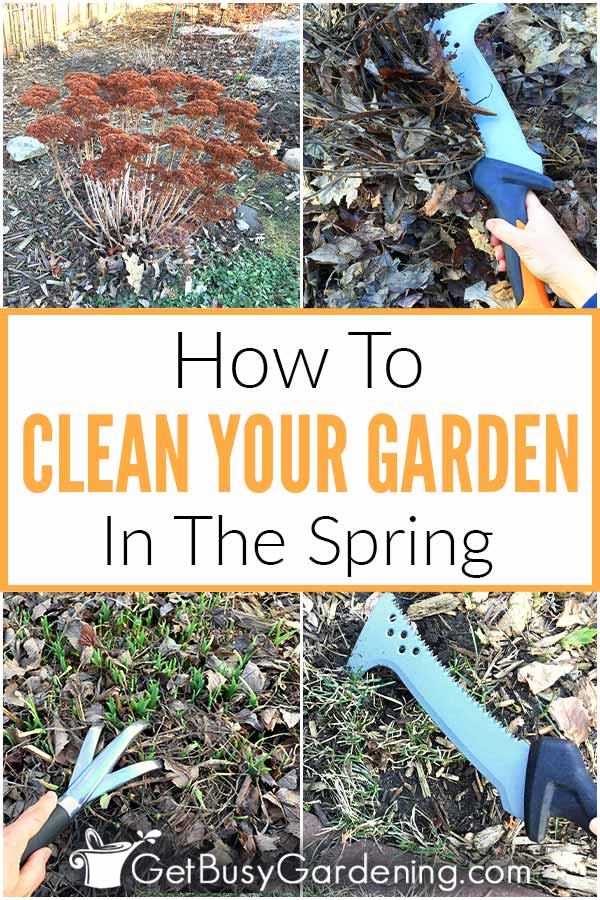
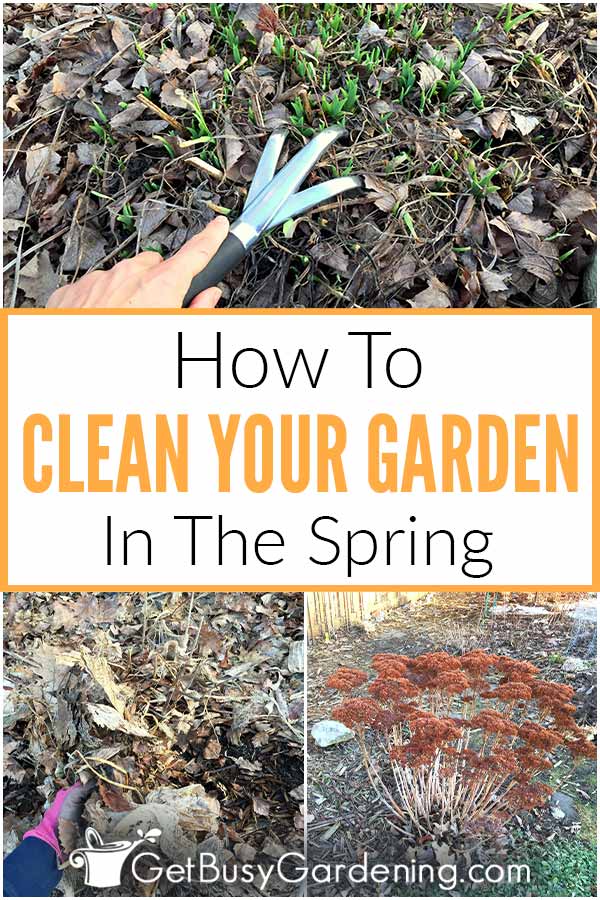
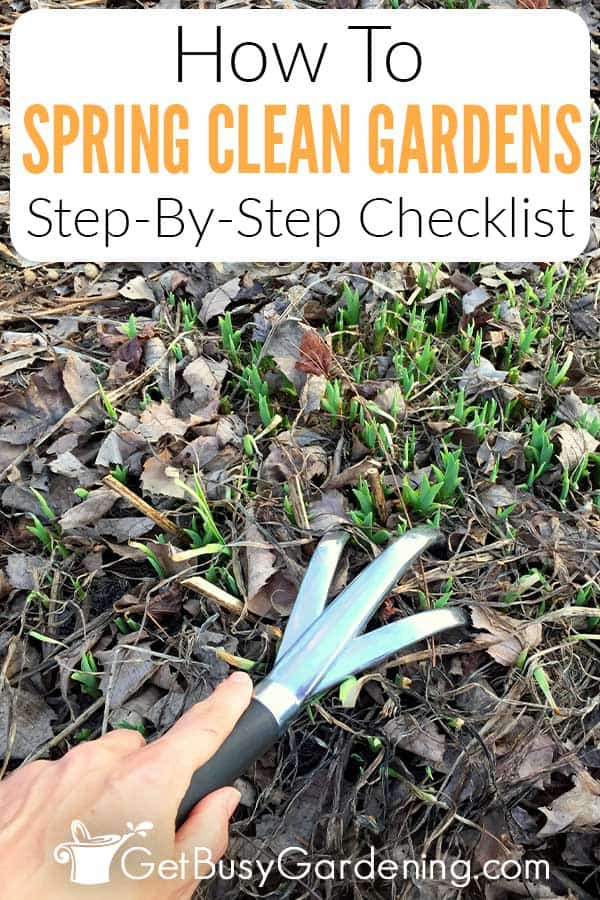
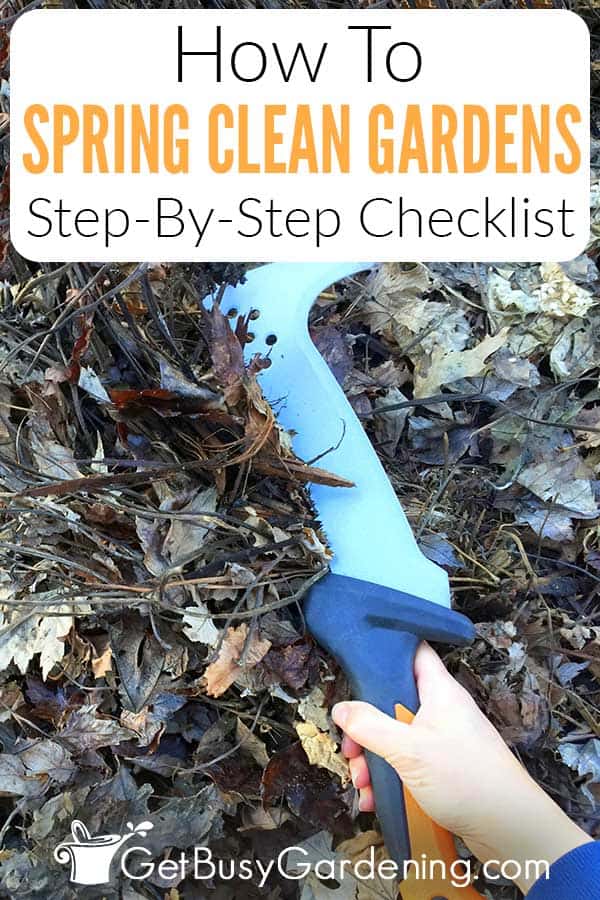
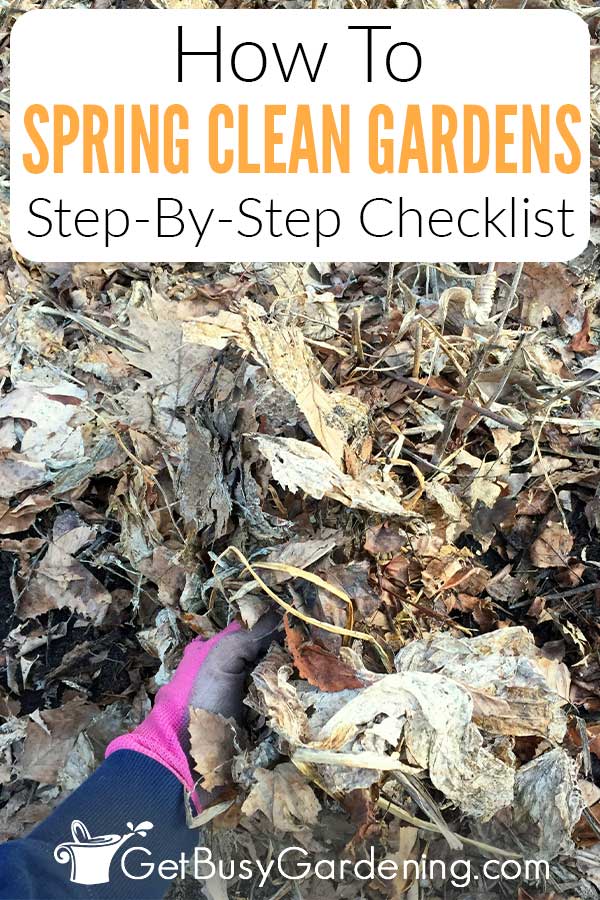
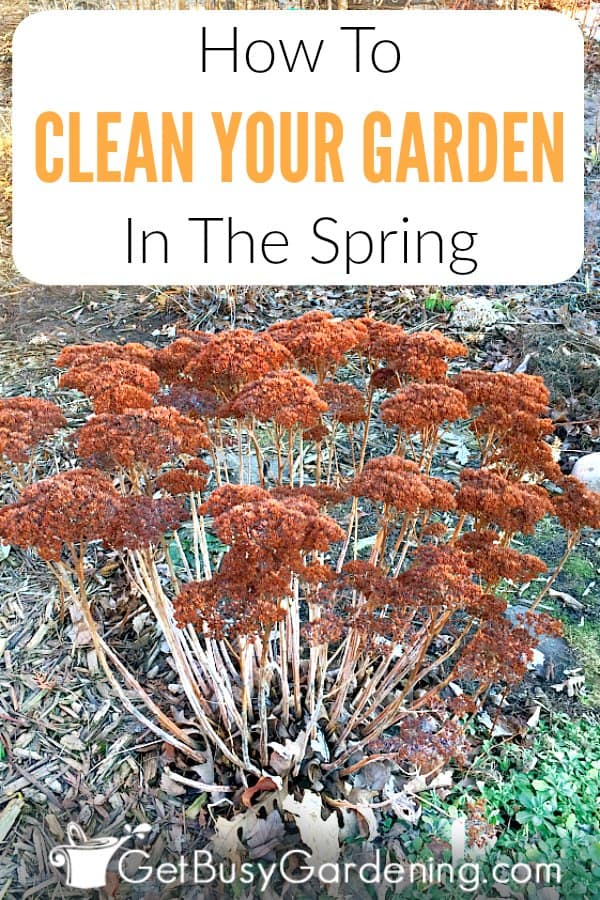

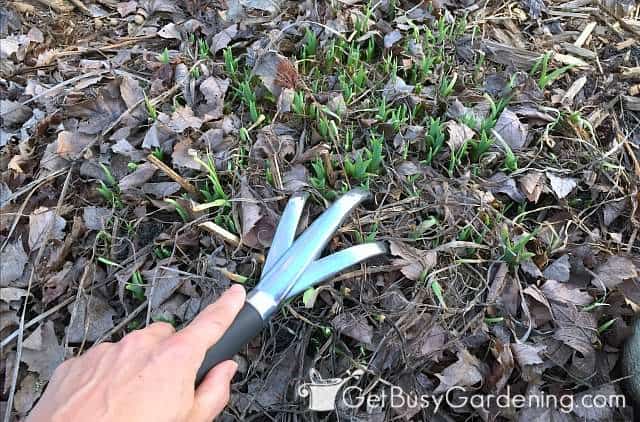
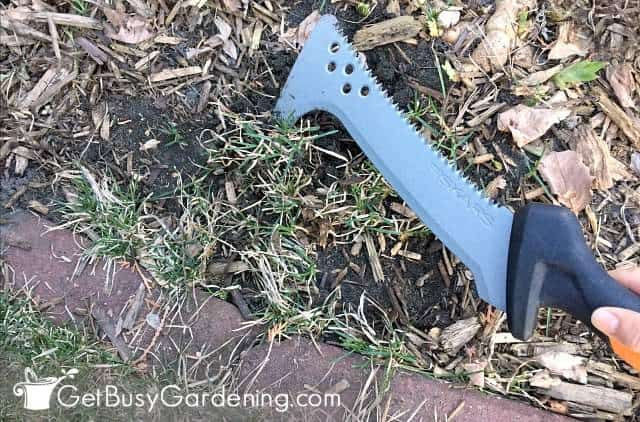
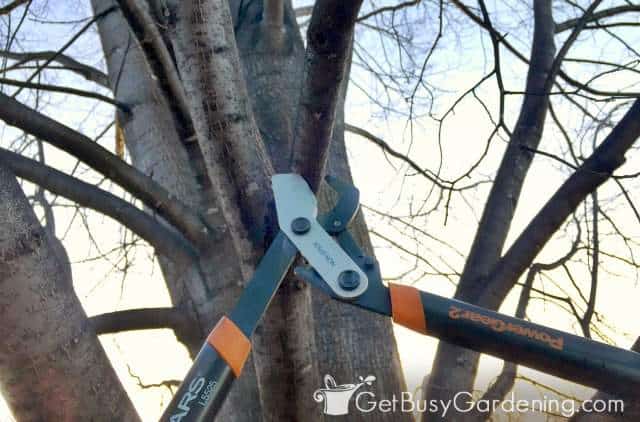

Mathiyazhagan says
Thank you for your valuable information. I hope these tips will help me to clean my backyard.
Amy Andrychowicz says
You’re welcome!
Ann says
Hi, Amy,
What tool do you use to edge your gardens? Thanks for your help.
Ann
Amy Andrychowicz says
I have plastic edging around all of my gardens to keep the grass out, so I don’t have to edge them too often. When it comes time to clean up the edges, I use a hand tool if it’s not too thick, or a flat blade shovel for the thicker stuff.
Linda Bradley says
I live in Zone 5b on a 1 acre rural property. Summers are getting hotter and drier. Fire season and drought is a reality. Last fall I added 6 to 8 inches straw to all vegetable and flower beds. As well as keeping weeds down and providing organic material to the soil, I am hoping it will help the soil retain moisture. But in the spring do I pull it all off and let the perennials grow, then put it back or just let the perennials grow up through the straw? Same sort of question for annuals and veggies. Do I remove straw and plant and then put straw back when plants are up? Or what? And everything looks messy. Thanks.
Amy Andrychowicz says
Yes, mulching will definitely help the soil retain moisture for longer. No need to clean it out in the spring. As long as they aren’t covered completely, the perennials will grow right through it. For annuals/veggies, just clear away enough of the straw to plant them.
Lauren says
I keep wanting to start a backyard garden, but then I see a list like that and wonder if I could get myself organized enough to do it. Your site has given me some inspiration though.
Amy Andrychowicz says
Oh no! My checklist wasn’t meant to discourage anyone, I’m sorry. I’m a little crazy when it comes to gardening, and you can certainly have beautiful beds without doing all of these things every spring. Just start small, and build from there. I’m glad to hear my site gives you inspiration though. 🙂
Lauren says
No Amy, please don’t apologize. I’m sure if I start small, the organization will come a little at a time. Just something to aspire to at this point. 😉
Amy Andrychowicz says
Yes, that is so true! It will come with time, just don’t put too much pressure on yourself. And most importantly, have fun!
Carlee says
Your to do list reminds me that I have a lot to get cracking on in my yard and garden!
Amy Andrychowicz says
Great, glad I could help get you motivated. 🙂
El Gaucho says
Good list, you should be plenty busy this Spring getting the garden set up. If Spring ever starts I might have enough time to finish my to do list, otherwise…who knows.
Amy Andrychowicz says
Thanks! Yes, I am always very busy this time of year. This weather is really putting us behind on our garden chores this spring. It’s no fun. Hope it will warm up soon.
Suze says
I cut poppy seed pods off last year, but shoots are coming up throughout my Small perennial garden. Do I pull, transplant to make it neater or just let it be?
Amy Andrychowicz says
Poppies don’t transplant very well. So you could certainly try moving them somewhere else, but they may not survive. Wait to do it on a cloudy day, and make sure they get plenty of water before and after.
Sally cornell says
Thank you so much for your very helpful and encouraging information. I went out early this evening feeling tense—of course, so much is going on, but it also related to the garden: what should I do and how can I get it done? One always forgets this stage—sort of like child labor. But your succinct and clear list and your expressing that it feels overwhelming were so helpful. I actually made some progress. Thank you!!!
Amy Andrychowicz says
You are welcome! I’m so happy to hear that you found this list helpful to get started on your spring garden cleanup! 🙂 Good for you for pushing through the overwhelm, and making progress on it! Sometimes getting started is the hardest part.
Laura says
I have a big list of spring garden cleaning to-do too, but it’s exciting to be back in the dirt again after all the snow. Nice post!
Amy Andrychowicz says
Thank you! Yes, I can totally relate to that! Enjoy digging in the dirt. 🙂
Lauren says
I keep wanting to start a backyard garden every spring, but then I see a cleanup list like that and wonder if I could get myself organized enough to do it. Your site has given me some inspiration though.
Amy Andrychowicz says
Oh no! My spring garden clean up checklist wasn’t meant to discourage anyone, I’m sorry. I’m a little crazy when it comes to gardening, and you can certainly have a beautiful garden without doing all of these things. ? Just start small, and build from there. I’m glad to hear my blog gives you inspiration.
Lauren says
No Amy, please don’t apologize. I’m sure if I start small, the checklist and organization will come a little at a time. Just something to aspire to at this point. 😉
Amy Andrychowicz says
Yes, that is so true! Getting used to managing all those spring garden cleanup tasks will come with time, just don’t put too much pressure on yourself. And most importantly, have fun!
Carlee says
Your list reminds me that I have a lot to get cracking on to get my gardens cleaned up this spring!
Amy Andrychowicz says
Great, glad I could help motivate you to get cracking on your spring garden cleanup. 🙂
El Gaucho says
Good list, you should be plenty busy this Spring getting the garden set up. I just wrote my Garden Goals for this year, and I think I”m regretting it. If Spring ever starts I might have enough time to finish, otherwise…who knows.
Amy Andrychowicz says
Thanks! Yes, I am always very busy this time of year too. I feel the same way every year… if spring ever begins, I might be able to get it all done. It can be overwhelming, but start with the most important stuff on the list first. The rest will get done when it gets done. 🙂
Jeannie says
Is there anything I can do if I say over pruned summer shrubs and there are no shoots.does this mean I killed them?
Amy Andrychowicz says
It depends on what shrubs you’re talking about, where you live, and also when you pruned them (sorry for the non-answer). I would give it more time to see if they recover before you give up.